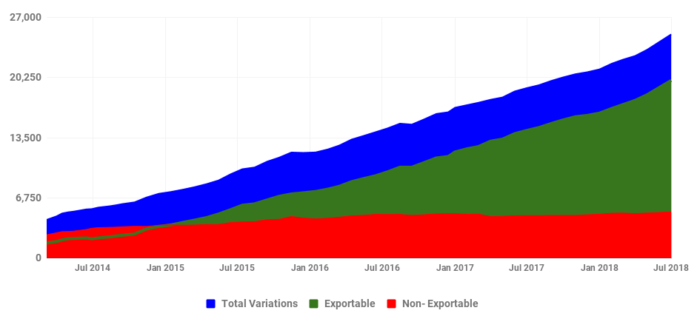In the comments section on one of the several InWorldz-related articles these past few days, I saw some people talking about whether OpenSim is safe for content. The idea being that InWorldz was somehow safer because it’s not OpenSim.
First, InWorldz IS OpenSim. It’s just another fork off the OpenSim code base, like many other grids have. It’s one of the older folks, but definitely not the only one. InWorldz developers have contributed code to mainline OpenSim, and have open sourced their fork of OpenSim — Halcyon — so that anything interesting in there can be brought over, as well.
The slogan “we’re not OpenSim” is just that — a marketing slogan. Like a restaurant rebranding its omelettes “UMMMlettes.” It also became a rallying cry for the grid and its supporters when its numbers starting trend downwards, making it look bad in comparison with the growth on other grids. They solved that problem, by improving service and lowering prices. No, my bad — they fixed that problem by no longer publishing their stats.
Second, if someone DOES want a closed grid, there are a few to choose from — The Adult Grid, Virtual Highway and DreamNation being the top three. Check them out. You’ll have to create a new user account, since they’re not hypergrid-enabled, but it’s free and doesn’t take too too long.
Third, being a closed grid ONLY offers protection for scripted items. Everything else, you can copybot. Remember that the biggest source of copybotted content in the metaverse is Second Life, a closed grid.
Fourth, there are filtered grids that offer THE BEST OF BOTH WORLDS.
Kitely allows creators to set their scripted content to no export, meaning that the content can only be used on the Kitely Grid. This applies to all types of content — prim objects, meshes, scripts, and textures. They won’t get saved to customer OARs, customers can’t teleport with them to other grids. And for everything else, creators can set the content to exportable, meaning that they get to benefit from having customers all over the hypergrid.
Kitely began filtering back in 2011. Other grids have also been rolling out such filters. If your grid is one of them, email me and I’ll add it to this article.
Finally, please remember that copybotters and thieves ARE NOT CUSTOMERS. They are crooks. They collect stolen stuff — they wouldn’t have bought legitimate copies of it, anyway. It’s like those teenagers with thousands of pirated MP3. Would they have bought all those records full price? No.
And they’re not going to bother buying the content first. They’ll teleport in to a commercial store that has what they need, and copybot it.
Legitimate customers WANT to support creators, DON’T MIND paying a few cents to a couple of bucks for content they want, and don’t want the embarrassment and liability of having stolen content in their inventories and builds.
Make it as easy and convenient for your real customers to find you. Sell it on hypergrid-enabled grids for Gloebits, sell it on the Kitely Market, and give away last season’s versions for marketing purposes in freebie stores — with hypergrid links to your official store in a notecard with every item.
Several grids have Gloebit shopping malls for hypergrid travelers, and many more offer free stores for merchants.
And when you see a freebie store with illegitimate content, report it — first, to the store owner (it may be an honest mistake), then to the region owner, then to the grid owner, and finally if all fails, file a DMCA takedown request with the registrar or hosting company, or email me, or post on OpenSim Virtual. In recent years, OpenSim grid owners have been VERY good at tracking down and removing illegitimate content.
How do you know all this is true? Look at the Kitely Market statistics. Since 2014, merchants have had a choice of whether to sell to hypergrid users or not. At first, only a few dipped their toes in. Was there enough money in it? Did it actually hurt sales?
Over time, more merchants opted to sell to people from throughout the OpenSim metaverse.
In the chart below, the blue area is the total amount of content available on the Kitely Market. According to the latest numbers from Kitely CEO Ilan Tochner, there are now more than 25,000 variations of more than 12,000 products. Kitely CEO Ilan Tocher might have updated numbers for this, and if I get them, I’ll add them in.
The red area at the bottom is the non-exportable content, which can only be used on Kitely itself. It can’t be saved to customer OAR files, or taken to other grids via hypergrid teleport.
Until 2015, exportable content was a small share of Kitely Market offerings — the red area, of non-exportable content, dominated for the first year that hypergrid deliveries were available.

But, since then, the amount of non-exportable content, the red area, has stayed pretty much flat.
All the growth has been in the exportable content — the green area above. Today, 79 percent of all content on the Kitely Market can be bought by residents of other grids, or taken to other grids by Kitely users — for example, in the clothes they are wearing as they travel the hypergrid.
People from more than 270 different grids can get content delivered from the Kitely Market. Hypergrid-enabled grids work by default, closed grids have to configure their settings.
So if you are a merchant or content creator, being on the hypergrid won’t hurt. But it will open up almost the entire OpenSim user base for you as potential customers.
- Kitely Mega Worlds on sale for $90 per month - July 19, 2024
- OpenSim regions up, actives down with summer heat - July 15, 2024
- People think AIs are conscious. What could this mean for bots in OpenSim? - July 12, 2024
